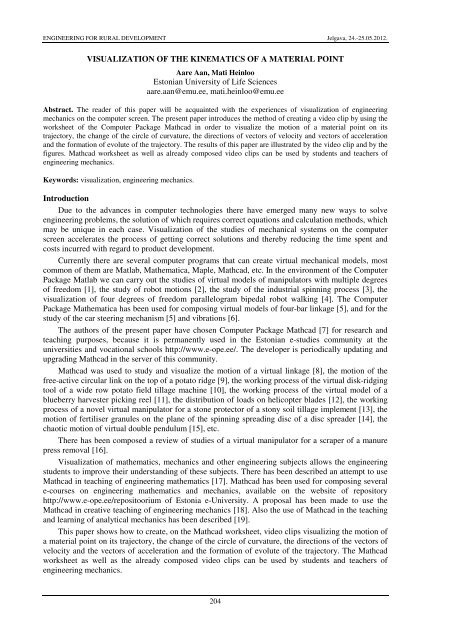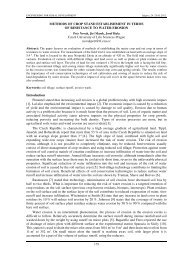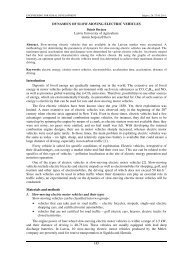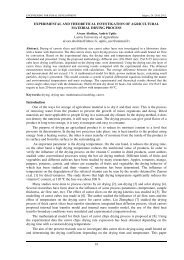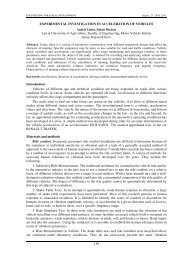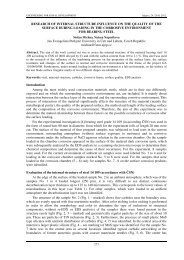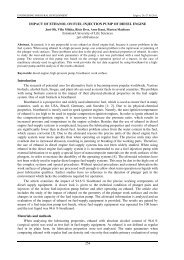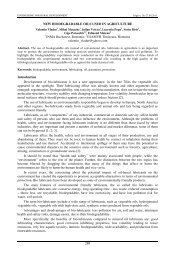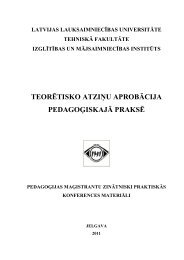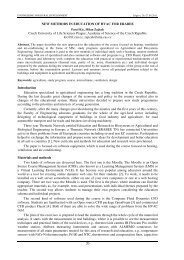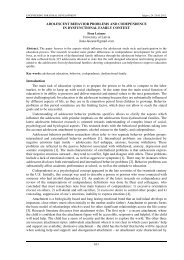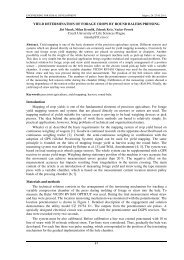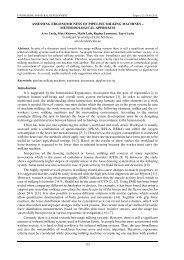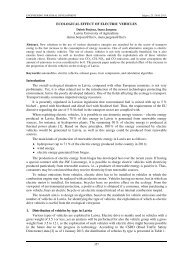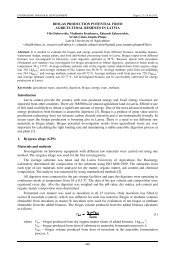Aare Aan, Mati Heinloo Estonian University of Life Sciences ...
Aare Aan, Mati Heinloo Estonian University of Life Sciences ...
Aare Aan, Mati Heinloo Estonian University of Life Sciences ...
Create successful ePaper yourself
Turn your PDF publications into a flip-book with our unique Google optimized e-Paper software.
ENGINEERING FOR RURAL DEVELOPMENT Jelgava, 24.-25.05.2012.VISUALIZATION OF THE KINEMATICS OF A MATERIAL POINT<strong>Aare</strong> <strong>Aan</strong>, <strong>Mati</strong> <strong>Heinloo</strong><strong>Estonian</strong> <strong>University</strong> <strong>of</strong> <strong>Life</strong> <strong>Sciences</strong>aare.aan@emu.ee, mati.heinloo@emu.eeAbstract. The reader <strong>of</strong> this paper will be acquainted with the experiences <strong>of</strong> visualization <strong>of</strong> engineeringmechanics on the computer screen. The present paper introduces the method <strong>of</strong> creating a video clip by using theworksheet <strong>of</strong> the Computer Package Mathcad in order to visualize the motion <strong>of</strong> a material point on itstrajectory, the change <strong>of</strong> the circle <strong>of</strong> curvature, the directions <strong>of</strong> vectors <strong>of</strong> velocity and vectors <strong>of</strong> accelerationand the formation <strong>of</strong> evolute <strong>of</strong> the trajectory. The results <strong>of</strong> this paper are illustrated by the video clip and by thefigures. Mathcad worksheet as well as already composed video clips can be used by students and teachers <strong>of</strong>engineering mechanics.Keywords: visualization, engineering mechanics.IntroductionDue to the advances in computer technologies there have emerged many new ways to solveengineering problems, the solution <strong>of</strong> which requires correct equations and calculation methods, whichmay be unique in each case. Visualization <strong>of</strong> the studies <strong>of</strong> mechanical systems on the computerscreen accelerates the process <strong>of</strong> getting correct solutions and thereby reducing the time spent andcosts incurred with regard to product development.Currently there are several computer programs that can create virtual mechanical models, mostcommon <strong>of</strong> them are Matlab, Mathematica, Maple, Mathcad, etc. In the environment <strong>of</strong> the ComputerPackage Matlab we can carry out the studies <strong>of</strong> virtual models <strong>of</strong> manipulators with multiple degrees<strong>of</strong> freedom [1], the study <strong>of</strong> robot motions [2], the study <strong>of</strong> the industrial spinning process [3], thevisualization <strong>of</strong> four degrees <strong>of</strong> freedom parallelogram bipedal robot walking [4]. The ComputerPackage Mathematica has been used for composing virtual models <strong>of</strong> four-bar linkage [5], and for thestudy <strong>of</strong> the car steering mechanism [5] and vibrations [6].The authors <strong>of</strong> the present paper have chosen Computer Package Mathcad [7] for research andteaching purposes, because it is permanently used in the <strong>Estonian</strong> e-studies community at theuniversities and vocational schools http://www.e-ope.ee/. The developer is periodically updating andupgrading Mathcad in the server <strong>of</strong> this community.Mathcad was used to study and visualize the motion <strong>of</strong> a virtual linkage [8], the motion <strong>of</strong> thefree-active circular link on the top <strong>of</strong> a potato ridge [9], the working process <strong>of</strong> the virtual disk-ridgingtool <strong>of</strong> a wide row potato field tillage machine [10], the working process <strong>of</strong> the virtual model <strong>of</strong> ablueberry harvester picking reel [11], the distribution <strong>of</strong> loads on helicopter blades [12], the workingprocess <strong>of</strong> a novel virtual manipulator for a stone protector <strong>of</strong> a stony soil tillage implement [13], themotion <strong>of</strong> fertiliser granules on the plane <strong>of</strong> the spinning spreading disc <strong>of</strong> a disc spreader [14], thechaotic motion <strong>of</strong> virtual double pendulum [15], etc.There has been composed a review <strong>of</strong> studies <strong>of</strong> a virtual manipulator for a scraper <strong>of</strong> a manurepress removal [16].Visualization <strong>of</strong> mathematics, mechanics and other engineering subjects allows the engineeringstudents to improve their understanding <strong>of</strong> these subjects. There has been described an attempt to useMathcad in teaching <strong>of</strong> engineering mathematics [17]. Mathcad has been used for composing severale-courses on engineering mathematics and mechanics, available on the website <strong>of</strong> repositoryhttp://www.e-ope.ee/repositoorium <strong>of</strong> Estonia e-<strong>University</strong>. A proposal has been made to use theMathcad in creative teaching <strong>of</strong> engineering mechanics [18]. Also the use <strong>of</strong> Mathcad in the teachingand learning <strong>of</strong> analytical mechanics has been described [19].This paper shows how to create, on the Mathcad worksheet, video clips visualizing the motion <strong>of</strong>a material point on its trajectory, the change <strong>of</strong> the circle <strong>of</strong> curvature, the directions <strong>of</strong> the vectors <strong>of</strong>velocity and the vectors <strong>of</strong> acceleration and the formation <strong>of</strong> evolute <strong>of</strong> the trajectory. The Mathcadworksheet as well as the already composed video clips can be used by students and teachers <strong>of</strong>engineering mechanics.204
ENGINEERING FOR RURAL DEVELOPMENT Jelgava, 24.-25.05.2012.Basic formulasIf the curve is represented by the parametric equations x = x(t), y = y(t), then the radius <strong>of</strong>curvature at the point M (x(t), y(t)) is [20]R( t)=ay3v( t)( t) ⋅v( t) − a ( t) ⋅v( t)xxy(1)The centre <strong>of</strong> curvature co-ordinates x and y are α(t) and β(t),respectivelyαβ( t) = x( t)( t) = y( t)−ay+a2v( t) ⋅ vy( t),( t) ⋅ vx( t) − vy( t) ⋅ ax( t)v( t) 2⋅ vx( t)( t) ⋅ v ( t) − v ( t) ⋅ a ( t) .yxyx(2)In (1) and (2)vaxdd= ,y(3)dt dt( t) x( t) v ( t) y( t)x=22dd=y(4)dtdt( t) x( t) , a ( t) = y( t)v( t) v ( t) 2 v ( t) 2= (5)x+Let us suppose now that a material point M is moving according to the lawx t = A⋅cosω ⋅ty( ) ( )( t) = B ⋅sin( ω ⋅t)where a, b and ω are constants and t is the time.The formulas (6) determine the trajectory <strong>of</strong> the point M. The formulas (3) and (4) determine theprojections <strong>of</strong> velocity and acceleration <strong>of</strong> the point M on the x – and y – co-ordinate axes <strong>of</strong> the coordinatesystem O xy . The formulas (5) represent the modules <strong>of</strong> the vectors <strong>of</strong> velocity <strong>of</strong> the point M.The direction angles between the x-axis and vectors <strong>of</strong> velocity v ( t)and acceleration ( t)αv( t) = angle( vx( t) , vy( t))α ( t) = angle a ( t) , a ( t)ay( )xya arewhere angle(x, y) returns on the worksheet <strong>of</strong> Mathcad in the direction angle (in radians) <strong>of</strong> avector.The direction angle <strong>of</strong> the vector, directed from the point M to the centre <strong>of</strong> curvature, iswherep( t) = angle( α( t) − x( t) β ( t) − y( t))α ,a( t) = a ( t) 2 a ( t) 2x+The circle <strong>of</strong> curvature is determined by the following parametric equationsxykk( t) = α(t) + R( t) ⋅cos( q)( t) = β ( t) + R( t) ⋅sin( q)y(6)205
ENGINEERING FOR RURAL DEVELOPMENT Jelgava, 24.-25.05.2012.where q = 0, 1, 2,…2π. The tangential acceleration is defined by the formula [22]( t) ⋅vx( t) + ay( t) ⋅ vy( t)v( t)and the normal acceleration is defined by the formula( ) ( )( α( t) − x( t))ant = axt ⋅ + ayR taxaτ ( t)=(7)( )206( t)The columns F(t, γ, b, n) (1) and F(t, γ, b, n) (2) <strong>of</strong> matrix functionF( t , γ , b , n) := x ← x( t)y ←y ( t)⎛V 0 ← ⎜⎝⎛I ← ⎜⎝Ω←⎛⎜⎝00xyxy0.850xycos( γ ( t))xy0.850.03−sin( γ ( t))V 0 + n⋅b( t)⋅I⋅Ωxy⋅10( β ( t) − y( t))R( t)Tx ⎞⎟y ⎠0.85−0.03sin( γ ( t)) ⎞ ⎟⎠cos( γ ( t))T0.85 ⎞ ⎟⎠0. (8)<strong>of</strong> Mathcad [21] can be used to simulate the movement <strong>of</strong> a geometric vector b r on Mathcadworksheet. In the function F(t, γ, b, n) the following notations are used: x = x(t) and y = y(t) are the coordinates<strong>of</strong> the origin, γ = γ (t) is the direction angle, b(t) is the module or projection (if the vector b ris determined only by one co-ordinate), and b is notation <strong>of</strong> b(t) <strong>of</strong> a vector b r ; m is the coefficient <strong>of</strong>dimensions and I is the matrix <strong>of</strong> the shape <strong>of</strong> a vector b r on Mathcad worksheet; Ω is the matrix <strong>of</strong>transformation <strong>of</strong> rotation, V 0 is the matrix <strong>of</strong> origin, T denotes the transposed matrix, t is the time.At the fixed moment <strong>of</strong> time t = T the columns <strong>of</strong> the matrix function F(t, γ, b, n)columnsVv( T ) ( 0) F( T, α , v,0.2) ( 0), V ( T ) ( 1)= F( T,α , v,0.2 ) ( 1)where v is the notation <strong>of</strong> module ( ) ( ) 2Va= ,vv2vytvvx t + , visualize the vector <strong>of</strong> velocity, the columns( T ) ( 0) F( T, α , v,0.1) ( 0), V ( T ) ( 1)= F( T,α , v,0.1 ) ( 1)= ,where a is the notation <strong>of</strong> module ( ) ( ) 2Vanaa2 aytaax t + visualize the vector <strong>of</strong> acceleration, the( T ) ( 0) F( T α , a ,0.1) ( 0), V ( T ) ( 1)= F( T,α , a ,0. 1 ) ( 1)= ,,p nanp nwhere a n is determined by the formula (8), visualize the vector <strong>of</strong> normal acceleration, thecolumnsV( T ) ( 0) F( T α , a ,0.1) ( 0), V ( T ) ( 1)F( T,α , a ,0. 1 ) ( 1)a τ,v τan=v τ= ,where a τ is determined by the formula (7), visualize the vector <strong>of</strong> tangential acceleration, thecolumnsVap( T ) ( 0) F( T, α , R,1) ( 0), V ( T ) ( 1)= F( T,α , R,1 ) ( 1)= ,pwhere R is determined by the formula (1), visualize the vector that begins from the point M and isdirected towards the centre <strong>of</strong> curvature (Fig. 1 and Fig. 2).app
ENGINEERING FOR RURAL DEVELOPMENT Jelgava, 24.-25.05.2012.ResultsLet us suppose, that T = 1.7 in (6) A = 3, B = 2, ω = π. Then the defined columns are⎡1.763⎤⎢⎢3.060⎢3.037( ) ( 0V ) vT = ⎢ , ( ) ( 1V ) vT = ⎢ , ( ) ( 0V ) aT = ⎢ , ( ) ( 1T) = ⎢⎢3.288⎢−0.879⎢0.023⎢−0.021⎢3.082⎢3.060⎥ ⎥⎥⎥⎥⎥⎥⎥ ⎢−1.036⎢⎦− 0.990⎥ ⎥⎥⎥⎥⎥⎥⎥ ⎢0.332⎢⎦0.284⎥ ⎥⎥⎥⎥⎥⎥⎥ ⎢−0.208⎢⎦− 0.261⎥ ⎥⎥⎥⎥⎥⎥⎥ ⎦⎣⎡1.763⎤⎢⎢0.950⎢0.890⎡−1.618⎤⎢⎢− 0.990⎢−0.944⎣⎡1.763⎤⎢⎢0.284⎢0.236⎣⎡−1.618⎤⎢⎢− 0.261⎢−0.313V a,( ) ( 0V ) anT = ⎢ , ( ) ( 1V ) anT = ⎢ , ( ) ( 0V ) aτT = ⎢ , ( ) ( 1T) = ⎢⎢0.806⎢ 0.358⎢0.980⎢−1.997⎢1.009⎢0.950⎥ ⎥⎥⎥⎥⎥⎥⎥ ⎢ 0.091⎢⎦− 0.062⎥ ⎥⎥⎥⎥⎥⎥⎥ ⎢1.086⎢⎦1.098⎥ ⎥⎥⎥⎥⎥⎥⎥ ⎢−1.917⎢⎦−1.940⎥ ⎥⎥⎥⎥⎥⎥⎥ ⎦⎣⎡−1.618⎤⎢⎢0.062⎢ 0.033⎣⎡1.763⎤⎢⎢0.552⎢0.464⎡1.763⎤⎢⎢1.098⎢1.109( ) ( 0V ) apT = ⎢ , ( ) ( 1T) = ⎢⎢0.338⎢ 1.324⎢0.640⎢0.552⎥ ⎥⎥⎥⎥⎥⎥⎥ ⎢ 0.925⎢⎦− 0.883⎥ ⎥⎥⎥⎥⎥⎥⎥ ⎦⎣⎡−1.618⎤⎢⎢0.883⎢ 0.840V ap.⎣⎣⎣⎡−1.618⎤⎢⎢−1.940⎢−1.964V aτ,In Fig. 2 these columns draw the vectors shown on the frame <strong>of</strong> the composed visualized videoclip when T = 1.7, if in (6) A = 3, B = 2,ω = π. In Fig. 1 the trajectory <strong>of</strong> the moving point M is a boldcurve, the circle <strong>of</strong> curvature is a thin curve, the curve with corners is the evolute drawn by the centre<strong>of</strong> curvature K, the bold vector <strong>of</strong> acceleration is directed to the centre <strong>of</strong> the co-ordinate system, thebold vector <strong>of</strong> normal acceleration is directed to the centre <strong>of</strong> curvature, the bold vector <strong>of</strong> tangentialacceleration is directed opposite the bold vector <strong>of</strong> velocity (this means that the motion is slowingdown at T = 1.7), the thin vector connects the point M and the centre <strong>of</strong> curvature K.The video clip, with the frame in Fig. 1, clearly shows the change <strong>of</strong> the point M vector modules<strong>of</strong> velocity and acceleration in time t. One can also see the motion and change <strong>of</strong> the radius <strong>of</strong> thecircle <strong>of</strong> curvature and the creation <strong>of</strong> the evolute as the trajectory <strong>of</strong> the centre <strong>of</strong> curvature.The composed Mathcad worksheet allows easy modification <strong>of</strong> Fig. 1. When replacing the law (6)withthen the frame 1 in Fig. 1 changes to Fig. 2.x( t) = t y( t) = 0.8⋅sin( 3⋅t), ,⎣207
ENGINEERING FOR RURAL DEVELOPMENT Jelgava, 24.-25.05.2012.Fig. 1. Frame from video clip: http://www.youtube.com/watch?v=zFbVcd4GOJwFig. 2. A frame <strong>of</strong> possible second video clip:http://www.youtube.com/watch?v=2gPSalH9lxU&feature=youtu.beConclusions1. The composed solution on the Mathcad worksheet and already created video clips allowexplaining the kinematics <strong>of</strong> a material point to the students.2. The environment <strong>of</strong> Mathcad allows observing how the formulas actually “work”.208
ENGINEERING FOR RURAL DEVELOPMENT Jelgava, 24.-25.05.2012.3. It is important that Mathcad detects most <strong>of</strong> syntax errors.4. The possibility <strong>of</strong> experimentation with lecture materials and composing animations makes thestudy <strong>of</strong> engineering subjects interesting and attractive for students.5. Simple procedure <strong>of</strong> animation on Mathcad worksheet allows visualization <strong>of</strong> the problems <strong>of</strong>engineering subjects for students.References1. Žlajpah, L. Simulation <strong>of</strong> n-R planar manipulators. Simulation Practice and Theory, vol. 6, 1998,pp 305-321.2. Žlajpah, L. 2008. Simulation in robotics. Mathematics and Computers in Simulation, vol. 79,1998, pp. 879-897.3. Tang, Z., Wang, X., Fraser W. B., Wang, L. Simulation and experimental validation <strong>of</strong> a ringspinning process. Simulation Modelling Practice and Theory, vol. 14, 2006, pp. 809-816.4. Jo H. S., Mir-Nasiri, N. Dynamic modeling and walk simulation for a new four-degree-<strong>of</strong>freedomparallelogram bipedal robot with sideways stability control. Mathematical and ComputerModelling, 20115. Peñuñuri, F., Peón-Escalante, R., Villanueva, C., Pech-Oy, D. Synthesis <strong>of</strong> mechanisms for singleand hybrid tasks using differential evolution. Mechanism and Machine Theory, vol. 46, 2011, pp.1335-1349.6. Chen, J. T., Chou, K. S., Kao, S. K. One-dimensional wave animation using Mathematica.Computer Applications in Engineering Education, vol. 17, 2009, pp. 323–339.7. Mathcad user's guide. Parametric Technology Corporation, 2007. [online] [31.01.2011]. Availableat: http://www.msmiami.com/custom/downloads/Mathcad14_Users_Guide_English.pdf.8. <strong>Heinloo</strong>, M., <strong>Aare</strong>nd, E., Mägi, M. On the Experience <strong>of</strong> Mathcad-Aided Analysis <strong>of</strong> PlanarLinkages. Proc. Tenth World Congress on the Theory <strong>of</strong> Machines and Mechanisms, vol. 1, 1999,pp. 392 – 397.9. <strong>Heinloo</strong>, M., Olt, J. Motion <strong>of</strong> the Free-Active Circular Link on the Top <strong>of</strong> a Potato RidgeModelled as a Polygonal Cylinder. Proc. Int. Conf. Perspective Sustainable Technological Processin Agricultural Engineering, 2001, pp. 99 – 104.10. <strong>Heinloo</strong>, M., Olt J. A method <strong>of</strong> virtual reality for creating a disk-ridging tool. CIGR Ejournal,vol. 8, 2006, pp. 21. [online] [31.02.2011]. Available at: http://cigr-ejournal.tamu.edu/.11. <strong>Heinloo</strong>, M. A virtual reality technology based method for study the working process <strong>of</strong> ablueberry harvester's picking reel. CIGR E-journal, vol. 9, 2007, pp. 12.12. Butoescu, V. A vortex model <strong>of</strong> a helicopter rotor. INCAS, vol. 1, 2009, pp. 23-27. [online][31.02.2011].Available at: http://bulletin.incas.ro/files/valentin_butoescu_v1no1_full.pdf.13. Olt, J., <strong>Heinloo</strong>, M. Visualization <strong>of</strong> the working process <strong>of</strong> a novel manipulator for a stoneprotector <strong>of</strong> a stony soil tillage implement. Balkan Agricultural Engineering Review, vol. 15,2010, pp. 9.14. Olt, J., <strong>Heinloo</strong> M. Visualization <strong>of</strong> Motion <strong>of</strong> Fertiliser’s Granules on the Plane <strong>of</strong> SpinningSpreading Disc <strong>of</strong> a Disc Spreader. Proc. XXXIV CIOSTA CIGR VConference, 2011, pp. 292 –296.15. <strong>Aan</strong>, A., <strong>Aare</strong>nd, E., <strong>Heinloo</strong>, M. On chaotic motion <strong>of</strong> a double pendulum. Agronomy Research,vol. 9, 2011, pp. 5 – 12.16. Leola, T., <strong>Heinloo</strong>, M. Review <strong>of</strong> Studies on Press Manure Removal. Proc. 10.th Int. Sci. Conf."Engineering for Rural Developments ", 2011, pp 82 – 87.17. <strong>Heinloo</strong>, M., Saks, E. Review <strong>of</strong> Experiences in the Interactive Teaching <strong>of</strong> Mathematics andMechanics. Proc. EFITA Conference, 2003, pp. 531–538.18. <strong>Aare</strong>, A., <strong>Heinloo</strong>, M. On Creative Teaching <strong>of</strong> Engineering Mechanics. Proc. 22nd DAAAMInternational World Symposium, 2011, pp. 1081 – 1082.19. <strong>Aan</strong>, A, <strong>Heinloo</strong>, M, <strong>Aare</strong>nd, E. Interactive Computer Aided Learning and Teaching <strong>of</strong> AnalyticalMechanics. Int. J. Eng. Pedagogy (iJEP), vol. 1, 2011, pp. 4 - 8.20. Piskunov, N. Differential and Integral Calculus I. Moscow, 1969, pp. 492.21. Bertjaev, B. D. Mathcad–based Training in Theoretical Mechanics (In Russian), Sankt-Peterburg,2005, pp. 738.22. Lepik, Ü., Roots, L. Theoretical mechanics (In <strong>Estonian</strong>). Tallinn, 1971, pp 483.209


